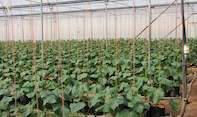
Hydroponics farming, a production method where plants are supplied with all their nutritional requirements and the growth medium is merely used to mechanically support plants, started in South Africa between 1930 and 1940, when Dutch flower farmers brought their expertise to the country.
The huge difference in climatic conditions and variabilities and high cost of heating, resulted in production initially being concentrated in frost-free areas. At first only cut flowers were produced, but some of the farmers soon started trials with tomatoes, cucumber, peppers and lettuce varieties grown in this type of system, with techniques brought from Holland.
Eventually, in the later part of the previous century, open land fresh produce farmers visited Spain, Belgium and Holland to acquire in-depth experience of greenhouse farming and the use of growth media, hydroponics irrigation and fertigation systems.
Soon a body of experienced and active hydroponics fresh produce and flower farmers was established to represent the needs of the growing industry, called Association for Vegetables Under Protection (AVUP). The body was disbanded in 2007, after which Undercover Farming took over as a platform where producers could share ideas and access information.
The actual number of greenhouse farmers in South Africa is uncertain, but suppliers and markets estimate it around 4 500. In 2020, the major produce in order of output were tomatoes, cucumbers and sweet peppers followed by leafy greens, cannabis and then cut and potted flowers and plants.
The cut flower industry declined from 3 200 producers to a mere 240 because major stakeholders of Holland and other countries decided to move their business to Kenya, where they were able to negotiate better transactions and terms with the government.
Since the turn of the century, undercover farmers could be split into three groups: Extra-large farmers of longstanding that adopted latest management technologies, which had them employ less staff on-farm. Greenhouse farmers who have been going for 20 or more years, with steady markets and who constantly adapt to remain relevant. And, newer greenhouse farmers that are young, but agile and often came from a finance or commerce background.
A small number of developing and emerging greenhouse farmers, trained by the ARC and greenhouse producers, have also become well-established in the industry and supply major markets and retailers. Many of them have featured on television programs for their absolute devotedness to their businesses and the exceptional quality of the fresh produce and flowers they produce.
In general, most of the farms in the country are situated close to a market or on the main route to a city, with the farms measuring between ten to twenty hectares.
 Many different ways of farming are used in South Africa, ranging from intensive to extensive and free-range, conventional to organic, biodyn...
Many different ways of farming are used in South Africa, ranging from intensive to extensive and free-range, conventional to organic, biodyn...